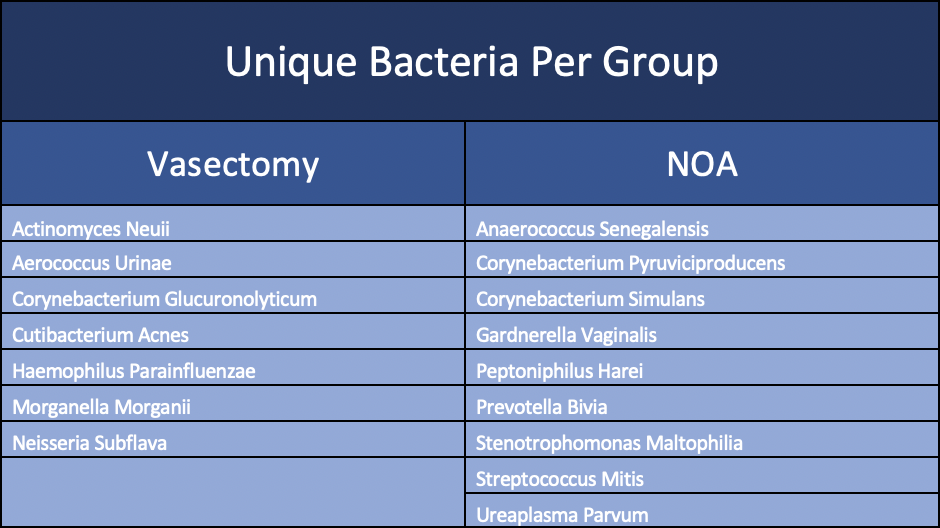Back
Poster, Podium & Video Sessions
Podium
PD09: Infertility: Epidemiology & Evaluation I
PD09-12: Is the Semen Microbiome Profile in Men with Non-Obstructive Azoospermia Different from Fertile Controls?
Friday, May 13, 2022
2:50 PM – 3:00 PM
Location: Room 252
Joseph M. Israeli*, Maria Camila Suarez, Daniel E. Nassau, Kevin Y. Chu, Emad Ibrahim, Ranjith Ramasamy, Miami, FL
- JI
Podium Presenter(s)
Introduction: Recent findings reveal a unique seminal microbiome, although the impacts of microorganism composition on fertility are uncertain. We hypothesized that there is a difference in the seminal microbiome between non-obstructive azoospermia (NOA) and fertile controls. To investigate, we compared semen samples from men with NOA and fertile controls – men with vasectomy. We compared alpha diversity, beta diversity, and differential frequencies/abundances of microbes.
Methods: This is a prospective study of male patients presenting for fertility evaluation at a single institution. History was recorded from chart review. NOA was diagnosed using clinical parameters (small testis size and FSH > 10 IU/mL). Single semen samples were collected at Urology office visit for semen analysis, and then sent for Next Generation Sequencing (NGS). NGS involves both quantitative PCR and 16s rRNA V1/V2 region comprehensive sequencing using Illumina MiSeq technology. Microorganism species and relative abundances were documented. Beta diversity between groups and differential species abundances were assessed using the Bray-Curtis Diversity Index and Independent Sample T-Tests respectively.
Results: Since August 2021, NOA patients (average age 38.1) and post-vasectomy patients (average age 36.3) were enrolled. Unique bacterial species numbered 20 (NOA), and 17 (vasectomy). The average number of species per patient was 5 (NOA) and 4.43 (vasectomy). The most frequent organisms in men with NOA and fertile controls were [C. Tuberculostearicum, F. Magna, and S. Epidermidis], and [E. Faecalis, S. Epidermidis, S. Hominis, and C. Tuberculostearicum] respectively. The most abundant organisms in men with NOA and fertile controls were [E. Faecalis, L. Iners, and E. Coli], and [E. Faecalis, S. Epidermidis, and C. Tuberculostearicum] respectively. Bacteria solely found in one group are displayed in Table 1. The Bray-Curtis value of 0.47 reveals a substantial amount of beta diversity between groups.
Conclusions: The seminal microbiome in NOA is different in composition and abundance from that of fertile controls. This is the first study to compare the microbiome in cases of NOA vs fertile controls. Further study is needed to determine the clinical utility of these observations.
Source of Funding: Investigator Initiated Grant Supported by MicrogenDx to RR. This work was supported by National Institutes of Health Grant R01 DK130991.

Methods: This is a prospective study of male patients presenting for fertility evaluation at a single institution. History was recorded from chart review. NOA was diagnosed using clinical parameters (small testis size and FSH > 10 IU/mL). Single semen samples were collected at Urology office visit for semen analysis, and then sent for Next Generation Sequencing (NGS). NGS involves both quantitative PCR and 16s rRNA V1/V2 region comprehensive sequencing using Illumina MiSeq technology. Microorganism species and relative abundances were documented. Beta diversity between groups and differential species abundances were assessed using the Bray-Curtis Diversity Index and Independent Sample T-Tests respectively.
Results: Since August 2021, NOA patients (average age 38.1) and post-vasectomy patients (average age 36.3) were enrolled. Unique bacterial species numbered 20 (NOA), and 17 (vasectomy). The average number of species per patient was 5 (NOA) and 4.43 (vasectomy). The most frequent organisms in men with NOA and fertile controls were [C. Tuberculostearicum, F. Magna, and S. Epidermidis], and [E. Faecalis, S. Epidermidis, S. Hominis, and C. Tuberculostearicum] respectively. The most abundant organisms in men with NOA and fertile controls were [E. Faecalis, L. Iners, and E. Coli], and [E. Faecalis, S. Epidermidis, and C. Tuberculostearicum] respectively. Bacteria solely found in one group are displayed in Table 1. The Bray-Curtis value of 0.47 reveals a substantial amount of beta diversity between groups.
Conclusions: The seminal microbiome in NOA is different in composition and abundance from that of fertile controls. This is the first study to compare the microbiome in cases of NOA vs fertile controls. Further study is needed to determine the clinical utility of these observations.
Source of Funding: Investigator Initiated Grant Supported by MicrogenDx to RR. This work was supported by National Institutes of Health Grant R01 DK130991.


.jpg)
.jpg)